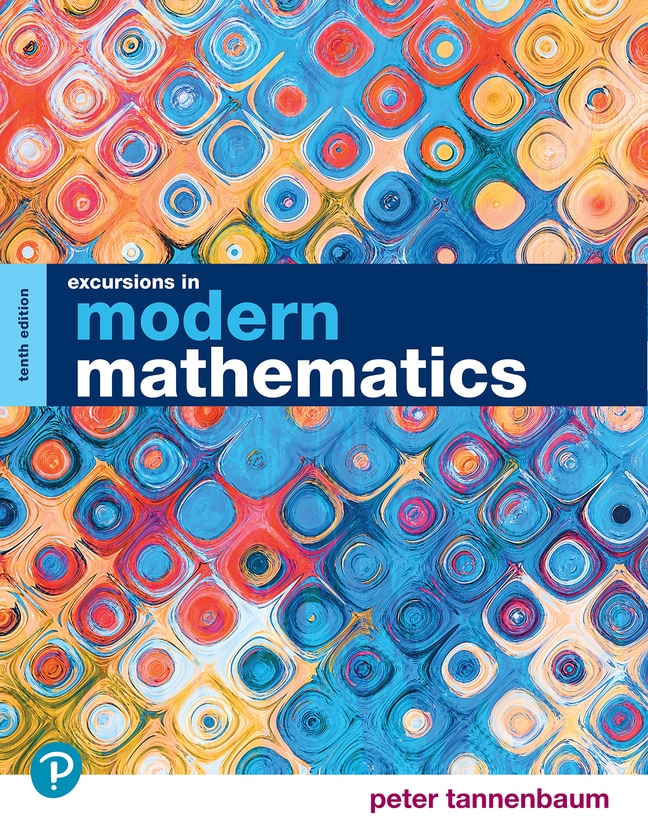
Excursions in Modern Mathematics, 10th edition
- Peter Tannenbaum

- Watch and learn
Videos & animations bring concepts to life
- Listen on the go
Learn how you like with full eTextbook audio
- Find it fast
Quickly navigate your eTextbook with search
- Stay organized
Access all your eTextbooks in one place
- Easily continue access
Keep learning with auto-renew
Excursions in Modern Mathematics shows you the power and beauty of math, and helps you approach it with a fresh perspective. New and updated examples from pop culture, sports, politics and science keep the discussion interesting and current: the COVID-19 pandemic, the role of vaccines, election polling and much more. Chapters are categorized by social choice, management science, growth, shape and form, and statistics, and can be used in any order. Key Concepts charts at the end of every chapter make it easy to study and review the material. The 10th Edition refines and updates examples and exercises and adds resources for both students and instructors, making it a relevant, accessible and complete program.
Published by Pearson (June 29th 2021) - Copyright © 2022
ISBN-13: 9780137423354
Subject: Liberal Arts Math
Category: Liberal Arts Math
PART I: SOCIAL CHOICE
1. The Mathematics of Elections: The Paradoxes of Democracy
1.1 The Basic Elements of an Election
1.2 The Plurality Method
1.3 The Borda Count Method
1.4 The Plurality-with-Elimination Method
1.5 The Method of Pairwise Comparisons
1.6 Fairness Criteria and Arrow's Impossibility Theorem
Conclusion
Key Concepts
Exercises
2. The Mathematics of Power: Weighted Voting
2.1 An Introduction to Weighted Voting
2.2 Banzhaf Power
2.3 Shapley-ShubikPower
2.4 Subsets and Permutations
Conclusion
Key Concepts
Exercises
3. The Mathematics of Sharing: Fair-Division Games
3.1 Fair-Division Games
3.2 The Divider-Chooser Method
3.3 The Lone-Divider Method
3.4 The Lone-Chooser Method
3.5 The Method of Sealed Bids
3.6 The Method of Markers
Conclusion
Key Concepts
Exercises
4. The Mathematics of Apportionment: Making the Rounds
4.1 Apportionment Problems and Apportionment Methods
4.2 Hamilton's Method
4.3 Jefferson's Method
4.4 Adams's and Webster's Methods
4.5 The Huntington-Hill Method
4.6 The Quota Rule and Apportionment Paradoxes
Conclusion
Key Concepts
Exercises
PART II: MANAGEMENT SCIENCE
5. The Mathematics of Getting Around: Euler Paths and Circuits
5.1 Street-Routing Problems
5.2 An Introduction to Graphs
5.3 Euler's Theorems and Fleury's Algorithm
5.4Eulerizingand Semi-EulerizingGraphs
Conclusion
Key Concepts
Exercises
6. The Mathematics of Touring: Traveling Salesman Problems
6.1 What Is a Traveling Salesman Problem?
6.2 Hamilton Paths and Circuits
6.3 The Brute-Force Algorithm
6.4 The Nearest-Neighbor and Repetitive Nearest-Neighbor Algorithms
6.5 The Cheapest-Link Algorithm
Conclusion
Key Concepts
Exercises
7. The Mathematics of Networks: The Cost of Being Connected
7.1 Networks and Trees
7.2 Spanning Trees, MSTs, andMaxSTs
7.3 Kruskal's Algorithm
Conclusion
Key Concepts
Exercises
8. The Mathematics of Scheduling: Chasing the Critical Path
8.1 An Introduction to Scheduling
8.2 Directed Graphs
8.3 Priority-List Scheduling
8.4 The Decreasing-Time Algorithm
8.5 Critical Paths and the Critical-Path Algorithm
Conclusion
Key Concepts
Exercises
PART III: GROWTH
9. Population Growth Models: There Is Strength in Numbers
9.1 Sequences and Population Sequences
9.2 The Linear Growth Model
9.3 The Exponential Growth Model
9.4 The Logistic Growth Model
Conclusion
Key Concepts
Exercises
10. Financial Mathematics: Money Matters
10.1 Percentages
10.2 Simple Interest
10.3 Compound Interest
10.4 Retirement Savings
10.5 Consumer Debt
Conclusion
Key Concepts
Exercises
PART IV: SHAPE AND FORM
11. The Mathematics of Symmetry: Beyond Reflection
11.1 Rigid Motions
11.2 Reflections
11.3 Rotations
11.4 Translations
11.5 Glide Reflections
11.6 Symmetries and Symmetry Types
11.7 Patterns
Conclusion
Key Concepts
Exercises
12. Fractal Geometry: The Kinky Nature of Nature
12.1 The Koch Snowflake and Self-Similarity
12.2 The Sierpinski Gasket and the Chaos Game
12.3 The Twisted Sierpinski Gasket
12.4 The Mandelbrot Set
Conclusion
Key Concepts
Exercises
13. Fibonacci Numbers and the Golden Ratio: Tales of Rabbits and Gnomons
13.1 Fibonacci Numbers
13.2 The Golden Ratio
13.3 Gnomons
13.4 Spiral Growth in Nature
Conclusion
Key Concepts
Exercises
PART V: STATISTICS
14.Censuses, Surveys, Polls, and Studies: The Joys of Collecting Data
14.1 Enumeration
14.2 Measurement
14.3 Cause and Effect
Conclusion
Key Concepts
Exercises
15. Graphs, Charts, and Numbers: The Data Show and Tell
15.1 Graphs and Charts
15.2 Means, Medians, and Percentiles
15.3 Ranges and Standard Deviations
Conclusion
Key Concepts
Exercises
16. Probabilities, Odds, and Expectations: Measuring Uncertainty and Risk
16.1 Sample Spaces and Events
16.2 The Multiplication Rule, Permutations, and Combinations
16.3 Probabilities and Odds
16.4 Expectations
16.5 Measuring Risk
Conclusion
Key Concepts
Exercises
17. The Mathematics of Normality: The Call of the Bell
17.1 Approximately Normal Data Sets
17.2 Normal Curves and Normal Distributions
17.3 Modeling Approximately Normal Distributions
17.4 Normality in Random Events
Conclusion
Key Concepts
Exercises
Answers to Selected Exercises
Credits
Index
Index of Applications